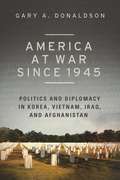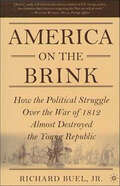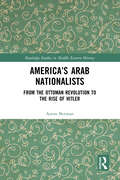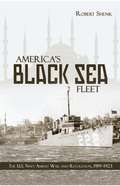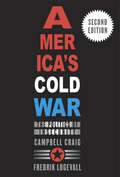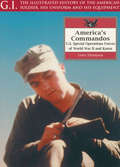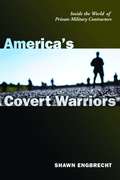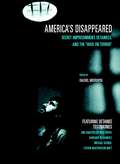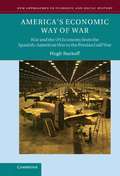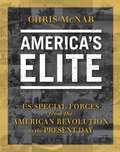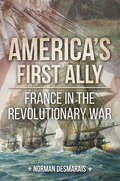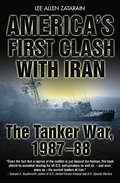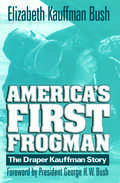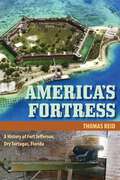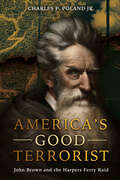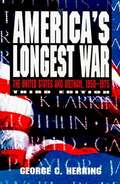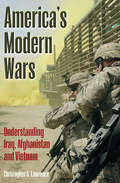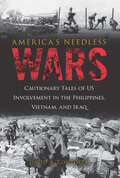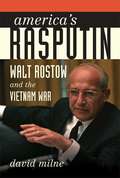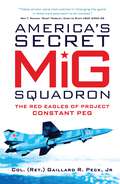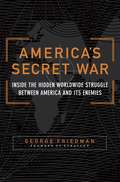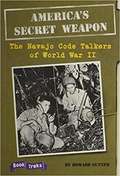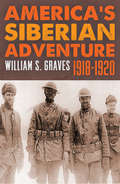- Table View
- List View
America at War since 1945: Politics and Diplomacy in Korea, Vietnam, Iraq, and Afghanistan
by Gary A. DonaldsonFocusing primarily on politics and foreign policy, America at War since 1945 analyzes America's involvement in its several wars since the end of World War II. The main questions asked are: How did the U.S. become involved in these wars? How were the wars conducted? And how did the U.S. get out of these wars?In Korea and Vietnam, the US fought to show the world that it would stand up to the evils of communism-that it could be counted on (with money, advisors, or even a major military effort if necessary) to halt the advance of communism. But in both wars, the US showed itself to be militarily vulnerable. In its wars against radical Islam since 9/11, the United States has made use of its military to protect its interests in the Middle East, particularly its oil interests, while trying to spread its ideas of democracy, constitutionalism, and the rule of law. The lessons are clear: America's values often do not translate into the less-developed world.In 2016, as the debate over ISIS intensifies, America at War since 1945 reminds us that the history of US postwar military conflict has seldom been marked by clearly defined goals and outcomes. Skyhorse Publishing, as well as our Arcade imprint, are proud to publish a broad range of books for readers interested in history--books about World War II, the Third Reich, Hitler and his henchmen, the JFK assassination, conspiracies, the American Civil War, the American Revolution, gladiators, Vikings, ancient Rome, medieval times, the old West, and much more. While not every title we publish becomes a New York Times bestseller or a national bestseller, we are committed to books on subjects that are sometimes overlooked and to authors whose work might not otherwise find a home.
America on the Brink: How the Political Struggle Over the War of 1812 Almost Destroyed the Young Republic
by Richard Buel Jr.The fascinating story of how New England Federalists threatened to dissolve the Union by making a separate peace with England during the War of 1812. Many people would be surprised to learn that the struggle between Thomas Jefferson's Republican Party and Alexander Hamilton's Federalist Party defined--and jeopardized--the political life of the early American republic. Richard Buel Jr.'s America on the Brink looks at why the Federalists, who worked so hard to consolidate the federal government before 1800, went to great lengths to subvert it after Jefferson's election. In addition to taking the side of the British in the diplomatic dance before the war, the Federalists did everything they could to impede the prosecution of the war, even threatening the Madison Administration with a separate peace for New England in 1814. Readers fascinated by the world of the Founding Fathers will come away from this riveting account with a new appreciation for how close the new nation came to falling apart almost fifty years before the Civil War.
America's Arab Nationalists: From the Ottoman Revolution to the Rise of Hitler (Routledge Studies in Middle Eastern History)
by Aaron BermanAmerica’s Arab Nationalists focuses in on the relationship between Arab nationalists and Americans in the struggle for independence in an era when idealistic Americans could see the Arab nationalist struggle as an expression of their own values. In the first three decades of the twentieth century (from the 1908 Ottoman revolution to the rise of Hitler), important and influential Americans, including members of the small Arab-American community, intellectually, politically and financially participated in the construction of Arab nationalism. This book tells the story of a diverse group of people whose contributions are largely unknown to the American public. The role Americans played in the development of Arab nationalism has been largely unexplored by historians, making this an important and original contribution to scholarship. This volume is of great interest to students and academics in the field, though the narrative style is accessible to anoyone interested in Arab nationalism, the conflict between Zionists and Palestinians, and the United States’ relationship with the Arab world.
America's Black Sea Fleet
by Robert ShenkIn a high-tempo series of operations throughout the Black Sea, Aegean Sea and eastern Mediterranean, a small American fleet of destroyers and other naval vessels responded ably to several major international crises including the last days of the Russian Revolution and the 1920-1922 Turkish Nationalist Revolution. Officers and men of the navy's "four-piper" destroyers began by investigating circumstances on the ground in mainland Turkey right after World War I, and by transporting American relief teams to ports throughout Turkey and Southern Russia to aid the tens of thousands of orphans and refugees who had survived the wartime Armenian genocide.Then the destroyers assisted in the final evacuation of 150,000 White Russians from the Crimea to Constantinople (one of the final acts of the Russian Revolution); coordinated the visits of the Hoover grain ships to ports in Southern Russia where millions were enduring a horrendous famine; witnessed and reported on the terrible dolorosa of the Greeks of the Pontus region of Turkey; and, in September of 1922, conducted the evacuation of hundreds of thousands of Greek and Armenian refugees from burning Smyrna. This latter event was the cataclysmic conclusion of the Turkish Nationalist Revolution, which had begun in early 1920.After Smyrna, the destroyers escorted Greek steamers in their rescue of ethnic Christian civilians being expelled from all the ports of Anatolian Turkey. As the conclusion of a long war between Nationalist Turks and an invading Hellenic Greek army, these people were being forced out of their ancestral homes by the Turks. Sometimes American destroyers carried hundreds of such refugees to friendly ports on their own weather decks.Upon the burning of Smyrna in September of 1922, Admiral Mark Bristol's small fleet had grown to some 26 naval vessels, most of them destroyers, although some cruisers, naval repair vessels and supply ships also came, and the battleships Arizona and Utah also appeared briefly. It was during 1922 that the destroyer Bainbridge rescued 482 of 495 men, women and children from the burning French transport Vinh Long in the Sea of Marmora. The destroyer accomplished this by the expedient of ramming the large French ship so the exploding ammunition could not continue to force the vessels apart. For this action, Lieut. Commander W. Atlee Edwards was awarded the Medal of Honor by America, and the Legion of Honor by France.Over four years, Admiral Bristol maintained a strong grip on American naval and diplomatic affairs throughout the region. Headquartered at the American Embassy at Constantinople, Bristol also worked to further American business interests in Turkey, and tended to favor Turks over Greeks and Armenians in the process. Many Americans were convinced that Bristol was biased on behalf of the Turks, and a couple of navy captains risked their careers by speaking out about impending Turkish massacres that Bristol wanted to hush up.Several later-famous admirals saw duty in Bristol's small navy, including William Leahy, Thomas Kinkaid, Julian Wheeler, Tip Merrill, Japy Hepburn and Dan Gallery, while statesman Allen Dulles was one of Bristol's key diplomats. Most of these men and most of the sailors, too, enjoyed the terrific nightlife of Constantinople that existed right alongside all the refugee heartbreak. When their duties kept them at sea or alongside grain ships in Russia or moored at the spartan Black Sea ports, the Americans kept their spirits up by racing ships' boats, shooting game, sightseeing, and (especially) by playing baseball. Captain Pratt Mannix even took advantage of his ship's briefly anchoring near the Gallipoli battlefield to become the first American to swim the famous Hellespont
America's Cold War: The Politics of Insecurity, Second Edition
by Fredrik Logevall Campbell Craig“A creative, carefully researched, and incisive analysis of U.S. strategy during the long struggle against the Soviet Union.” —Stephen M. Walt, Foreign Policy “Craig and Logevall remind us that American foreign policy is decided as much by domestic pressures as external threats. America's Cold War is history at its provocative best.” —Mark Atwood Lawrence, author of The Vietnam War The Cold War dominated world affairs during the half century following World War II. America prevailed, but only after fifty years of grim international struggle, costly wars in Korea and Vietnam, trillions of dollars in military spending, and decades of nuclear showdowns. Was all of that necessary? In this new edition of their landmark history, Campbell Craig and Fredrik Logevall include recent scholarship on the Cold War, the Reagan and Bush administrations, and the collapse of the Soviet regime and expand their discussion of the nuclear revolution and origins of the Vietnam War to advance their original argument: that America’s response to a very real Soviet threat gave rise to a military and political system in Washington that is addicted to insecurity and the endless pursuit of enemies to destroy. America’s Cold War speaks vividly to debates about forever wars and threat inflation at the center of American politics today.
America's Commandos: U.S. Special Operations Forces of World War II and Korea (G.I.)
by Leroy ThompsonA photographic history of elite units in WWII and Korea, including uniforms, equipment, and more. America deployed a diverse group of special operations forces (SOF) throughout World War II and in Korea. These elite units quickly earned a redoubtable reputation and proved themselves adept at hit-and-run raids, gathering intelligence in long range patrols, rescuing POWs, and living and fighting in hostile environments. This valuable study includes more than 100 rare and unusual photographs of the men, uniforms, special equipment, and insignia of these elite troops, accompanied by informative captions. Units covered include the Marine Raider regiments and Paramarines, Ranger battalions, &“Merrill&’s Marauders,&” the Special Service Force, OSS teams, Naval CDUs, and ski and mountain troops. America&’s Commandos is a key addition to the G.I. Series and examines some of America&’s most feared and capable elite forces.
America's Covert Warriors: Inside the World of Private Military Contractors
by Shawn Engbrecht<p>Private military contractors, especially those in Iraq, have taken on far more than their original mandates required. Initially intended for combat support, they have become full-fledged warriors, many with little experience, scant oversight, and no accountability to the rules of engagement that constrain the U.S. military and coalition forces. When the occupation of Iraq turned into a fight against an insurgency, overwhelming U.S. and coalition military forces, the demand for private military contractors skyrocketed in 2003 and 2004. The explosive growth of such firms as Blackwater, Crescent, and others resulted in a relaxation of recruitment standards at precisely the same time that the U.S. military’s own standards of recruitment began to falter, but the standards for private military contractors fell much further and faster. The predictable result included excessive civilian casualties, a human tragedy whose full dimensions have yet to be seen by the American public. <p>Shawn Engbrecht has been training and recruiting private military contractors for more than a decade. Acknowledging that some private military contractors are out of control, he argues that the oft-made suggestion to fire them all is not the solution. Instead, Engbrecht contends that with proper training and development of recruits, along with enforceable regulation and oversight, private security companies can be successfully integrated into a total force package with a professional operational staff.</p>
America's Dirty Wars
by Russell CrandallThis book examines the long, complex experience of American involvement in irregular warfare. It begins with the American Revolution in 1776 and chronicles big and small irregular wars for the next two and a half centuries. Examples taken from the American experience reveal that fighting - and, more so, winning - all types of wars is extraordinarily complex, frustrating, controversial and bloody. What is readily apparent in dirty wars is that failure is painfully tangible while success is often amorphous. Successfully fighting these wars often entails striking a critical balance between military victory and politics. America's status as a democracy only serves to make fighting - and, to a greater degree, winning - these irregular wars even harder. Rather than futilely insisting that Americans should not or cannot fight this kind of irregular war, Russell Crandall argues that we would be better served by considering how we can do so as cleanly and successfully as possible.
America's Disappeared: Secret Imprisonment, Detainees, and the War on Terror (Open Media Series)
by Barbara Olshansky Steven Macpherson Watt Reed Brody Rachel Meeropol Michael RatnerThe confirmation proceedings for Alberto R. Gonzales and Condeleezza Rice, like the Abu Ghraib prison scandal, triggered a national debate about the U.S. government's controversial treatment of detainees and its practice of torture. At the heart of the debate is the question: Is the United States undermining democracy, freedom, and human rights in it's effort to protect its citizens from terrorism? The authors of AMERICA'S DISAPPEARED answer, yes.AMERICA'S DISAPPEARED describes how the U.S. government, in response to the events of 9/11, launched an unprecedented campaign of racial profiling, detentions, and deportations so grievous as to evoke the internment of Japanese Americans during World War II. It brings together, for the first time, detainees' own testimonies along with analysis by the leading constitutional attorneys and human rights advocates. In addition to a detailed exploration of detention--the forms currently in use, and the conditions of each--the book challenges the Bush administration's justifications for violating the Geneva Conventions and the most basic definitions of human rights.
America's Economic Way of War: War and the US Economy from the Spanish-American War to the First Gulf War
by Hugh RockoffHow did economic and financial factors determine how America waged war in the twentieth century? This important new book exposes the influence of economics and finance on the questions of whether the nation should go to war, how wars would be fought, how resources would be mobilized, and the long-term consequences for the American economy. Ranging from the Spanish-American War to the Gulf War, Hugh Rockoff explores the ways in which war can provide unique opportunities for understanding the basic principles of economics as wars produce immense changes in monetary and fiscal policy and so provide a wealth of information about how these policies actually work. He shows that wars have been more costly to the United States than most Americans realize as a substantial reliance on borrowing from the public, money creation and other strategies to finance America's war efforts have hidden the true cost of war.
America's Economic Way of War: War and the US Economy from the Spanish-American War to the Persian Gulf War
by Hugh RockoffHow did economic and financial factors determine how America waged war in the twentieth century? This important new book exposes the influence of economics and finance on the questions of whether the nation should go to war, how wars would be fought, how resources would be mobilized, and the long-term consequences for the American economy. Ranging from the Spanish-American War to the Gulf War, Hugh Rockoff explores the ways in which war can provide unique opportunities for understanding the basic principles of economics as wars produce immense changes in monetary and fiscal policy and so provide a wealth of information about how these policies actually work. He shows that wars have been more costly to the United States than most Americans realize as a substantial reliance on borrowing from the public, money creation and other strategies to finance America's war efforts have hidden the true cost of war.
America's Elite: US Special Forces from the American Revolution to the Present Day
by Chris McnabFrom Roger's Rangers to the Revolution, Civil War, World War I & II, Korea, Vietnam, Iraq, Afghanistan, and the Bin Laden raid, this book covers over 250 years of American Special Forces action. America's Elite takes the reader through some of the most dramatic special forces operations in US history, from sniping British commanders during the Revolutionary War to Riverine incursions in the Mekong Delta in Vietnam, and from demolition missions on D-Day to the SEAL assault on Osama bin Laden's compound in 2011. Training and selection procedures are explained in detail, and the book also describes some of the technologies that have separated regular soldiers from their Special Forces counterparts. Illustrated throughout with striking photography and artworks, America's Elite forms the most comprehensive and visually impressive single-volume guide to US Special Forces available.
America's First Ally: France in the Revolutionary War (The Pocket Manual Series)
by Norman Desmarais<p>The Revolutionary War historian provides “a comprehensive and accessible guide” to the vital influence France had on America’s path to independence (Publishers Weekly).<p> <p>French support for United States independence was both vital and varied, ranging from ideological inspiration to financial and military support. In this study, historian Norman Desmarais offers an in-depth analysis of this crucial relationship, exploring whether America could have won its independence without its first ally.<p> <p>Demarais begins with the contributions of French Enlightenment thinkers who provided the intellectual frameworks for the American and French revolutions. He then covers the many forms of aid provided by France during the Revolutionary War, including the contributions of individual French officers and troops, as well as covert aid provided before the war began. France also provided naval assistance, particularly to the American privateers who harassed British shipping. Detailed accounts drawn from ships’ logs, court and auction records, newspapers, letters, diaries, journals, and pension applications.<p> <p>In a more sweeping analysis, Desmarais explores the international nature of a war which some consider the first world war. When France and Spain entered the conflict, they fought the Crown forces in their respective areas of economic interest. In addition to the engagements in the Atlantic Ocean, along the American and European coasts and in the West Indies, there are accounts of action in India and the East Indies, South America and Africa.<p>
America's First Clash with Iran: The Tanker War, 1987–88
by Lee Allen ZatarainA revealing account of the US conflict with Iran over the Persian Gulf during the Reagan era—and the groundwork it set for today&’s tensions. In May 1987, the US frigate Stark was blown apart by an Iraqi jet fighter in the Persian Gulf, jumpstarting a major conflict with Iran that came to be known as the Tanker War. In America&’s First Clash with Iran, author Lee Allen Zatarain employs Pentagon documents and firsthand interviews to reveal the full story of a conflict that may have presaged further battles to come. At the climax of the Iran-Iraq War, Iran was losing on the battlefield. Ayatollah Khomeini decided to close the Persian Gulf against shipping from Iraq&’s oil-rich backer, the emirate of Kuwait. When the United States sent a fleet to the Gulf, raising the Stars and Stripes over Kuwait&’s commercial tankers, a tinderbox was set off. The Iranians laid mines throughout the narrow passage and launched attack boats against both tankers and US warships. The US Navy fought its largest surface battle since World War II against the Ayatollah&’s assault boats. As Saddam Hussein looked on, Iranian gunners fired missiles against US forces—actions which, if made known at the time, would have required the US Congress to declare war against Iran.
America's First Frogman
by Elizabeth Kauffman BushAlthough bad eyesight kept him from receiving a commission in the U.S. Navy when he graduated from the Naval Academy in 1933, Draper Kauffman became a hero of underwater demolition in World War II and went on to a distinguished naval career. Today Admiral Kauffman is remembered as the nation's first frogman and the father of the Navy Seals. His spectacular wartime service disarming enemy bombs, establishing bomb disposal schools, and organizing and leading the Navy's first demolition units is the focus of this biography written by Kauffman's sister. Elizabeth Kauffman Bush, who also is the aunt of President George W. Bush, draws on family papers as well as Navy documents to tell Kauffman's story for the first time. Determined to defend the cause of freedom long before the U.S. ever entered the war, Kauffman was taken prisoner by the Germans as an ambulance driver in France, and after his release joined the Royal Navy to defuse delayed-action bombs during the London blitz. After Pearl Harbor his eyes were deemed adequate and he was given a commission in the U.S. Naval Reserve. With his experience, he was asked to establish an underwater demolition school in Fort Pierce, Florida, where he personally trained men to defuse bombs and neutralize other submerged dangers. His men were sent to demolish the obstacles installed by the Nazis at Normandy, and Kauffman himself led underwater demolition teams in the Pacific at Saipan, Tinian, and Guam and later directed UDT operations at Iwo Jima and Okinawa. His men remember him as an exceptional leader who led by example. He trained and fought alongside them, impervious to danger. Because of the high standards he set for those who became "frogmen,"thousands of American lives were saved in World War II, Korea, and Vietnam. Draper Kauffman's early established UDT traditions of perseverance, teamwork, and a lasting brotherhood of men of extraordinary courage is carried on by Navy Seals. This is his legacy to the U.S. Navy and his country.
America's Fortress: A History of Fort Jefferson, Dry Tortugas, Florida (Florida History and Culture)
by Thomas ReidA little-known Civil War outpost that was the most heavily armed coastal defense fort in United States historyKnown as the “American Gibraltar,” Fort Jefferson, located in the Dry Tortugas, Florida, was the most heavily armed coastal defense fort in United States history. Perceived as the nation’s leading maximum-security prison, the fort also held several of the accused conspirators in the Lincoln assassination. America’s Fortress is the first book-length, architectural, military, environmental, and political history of this strange and significant Florida landmark. This volume also fills a significant gap in Civil War history with regard to coastal defense strategy, support of the Confederacy blockade, the use of convicted Union soldiers as forced labor, and the treatment of civilian prisoners sentenced by military tribunals. Reid argues that Fort Jefferson’s troops faced very different threats and challenges than soldiers who served elsewhere during the war. He chronicles threats of epidemic tropical disease, hurricanes, shipwrecks, prisoner escapes, and Confederate attack. Reid also reports on white northerners’ perceptions of enslaved people, slavery, and the emerging free black soldiers of the latter years of the war. Drawing on the writings of Emily Holder, wife of Fort Jefferson’s resident surgeon, Reid is the first to offer a female perspective on life at the fort between 1859 and 1865. For history buffs and tourists, America's Fortress offers a fascinating account of this little-known outpost which has stood for over 160 years off the tip of the Florida Keys.
America's Good Terrorist: John Brown and the Harpers Ferry Raid
by Charles P. Poland Jr.<p>A biography of John Brown, examining his failed raid on Harpers Ferry, and the part his actions played in causing the Civil War.<p> <p>John Brown’s failed efforts at Harpers Ferry have left an imprint upon our history, and his story still swirls in controversy. Was he a madman who felt his violent solution to slavery was ordained by Providence or a heroic freedom fighter who tried to liberate the downtrodden slave? These polar opposite characterizations of the violent abolitionist have captivated Americans. The prevailing view from the time of the raid to well into the twentieth century—that his actions were the product of an unbalanced mind—has shifted to the idea that he committed courageous acts to undo a terrible injustice.<p> <p>Despite the differences between modern terrorist acts and Brown’s own violent acts, when Brown’s characteristics are compared to the definition of terrorism as set forth by scholars of terrorism, he fits the profile. Nevertheless, today Brown is a martyred hero who gave his life attempting to terminate the evil institution of human bondage. The modern view of Brown has unintentionally made him a “good terrorist,” despite the repugnance of terrorism that makes the thought of a benevolent or good terrorist an oxymoron.<p> <p>This biography covers Brown’s background and the context to his decision to carry out the raid, a detailed narrative of the raid and its consequences for both those involved and America; and an exploration of the changing characterization of Brown since his death.<p>
America's Longest War: The United States and Vietnam, 1950-1975 (3rd edition)
by George C. HerringAmericas Longest War provides a complete and balanced history of the Vietnam War. It is not mainly a military history, but seeks to integrate military, diplomatic, and political factors in order to clarify America's involvement and ultimate failure in Vietnam.
America's Modern Wars: Understanding Iraq, Afghanistan, and Vietnam
by Christopher A. Lawrence&“A well researched and well analyzed study of the nature of insurgencies and guerilla warfare&” (Military Review). The fighting skills and valor of the US military and its allies haven&’t diminished over the past half-century—yet our wars have become more protracted and decisive results more elusive. With only two exceptions—Panama and the Gulf War under the first President Bush—our campaigns have taken on the character of endless slogs without positive results. This fascinating book takes a ground-up look at the problem to assess how our strategic objectives have become divorced from our true capability or imperatives. The book presents a unique examination of the nature of insurgencies and the three major guerrilla wars the United States has fought in Iraq, Afghanistan, and Vietnam. It is both a theoretical work and one that applies the hard experience of the past five decades to address the issues of today. As such, it also provides a timely and meaningful discussion of America&’s current geopolitical position. It starts with the previously close-held casualty estimate for Iraq that The Dupuy Institute compiled in 2004 for the US Department of Defense. Going from the practical to the theoretical, it then discusses a construct for understanding insurgencies and the contexts in which they can be fought. It applies these principles to Iraq, Afghanistan, and Vietnam, assessing where the projection of US power can enhance our position and where it merely weakens it. It presents an extensive analysis of insurgencies based upon a unique database of eighty-three post-WWII cases. The book explores what is important to combat and what is not important to resist in insurgencies. It builds a body of knowledge, based upon a half-century&’s worth of real-world data, with analysis, not opinion. In these pages, Christopher A. Lawrence, the President of The Dupuy Institute, provides an invaluable guide to how the US can best project its vital power while avoiding the missteps of the recent past. &“Provides a unique quantitative historical analysis . . . Logically estimating the outcomes of future military operations, as the author writes, is what US citizens should expect and demand from their leaders who take this country to war.&” —Military Review
America's Needless Wars: Cautionary Tales of US Involvement in the Philippines, Vietnam, and Iraq
by David R. ContostaThis eye-opening book takes a unique approach to the history of U.S. foreign policy by examining three unrelated conflicts, all of which ended tragically and resulted in the deaths of millions on both sides. By analyzing what went wrong in each case, the author uncovers a pattern of errors that should serve as a precaution for future decision makers contemplating a conflict abroad. Why did President McKinley oppose Filipino independence forces if his motivation was truly to help Filipinos overthrow Spanish domination? Why did several U.S. presidents ignore the failures of the French in Vietnam and reject peace overtures from popular revolutionary leader Ho Chi Minh to bring the conflict to an early end? And how could American leaders have been so wrong about Saddam Hussein's alleged weapons of mass destruction and then let Iraq devolve into chaos after overthrowing the dictator? Historian David R. Contosta has sifted through official hearings, media investigations, public documents, memoirs of those for and against the conflicts, and numerous histories to uncover the answers to these questions. The common thread that links these wars from different centuries is that political leaders all too often have acted out of ignorance, arrogance, fear, and partisan gamesmanship. These lapses were compounded by the failure of the media to inform the public accurately and dispassionately. The sad result is that America has paid a high price in lost lives and tarnished national reputation. As the author notes in conclusion, if American exceptionalism is to have any meaning, then we must honestly appraise our past foreign-policy blunders to ensure wiser political action in the future.
America's Rasputin: Walt Rostow and the Vietnam War
by David MilneWalt Rostow's meteoric rise to power -- from Flatbush, Brooklyn, to the West Wing of the White House -- seemed to capture the promise of the American dream. Hailing from humble origins, Rostow became an intellectual powerhouse: a professor of economic history at MIT and an influential foreign policy adviser to John F. Kennedy and Lyndon B. Johnson. Too influential, according to some. While Rostow inspired respect and affection, he also made some powerful enemies. Averell Harriman, one of America's most celebrated diplomats, described Rostow as "America's Rasputin" for the unsavory influence he exerted on presidential decision-making. Rostow was the first to advise Kennedy to send U.S. combat troops to South Vietnam and the first to recommend the bombing of North Vietnam. He framed a policy of military escalation, championed recklessly optimistic reporting, and then advised LBJ against pursuing a compromise peace with North Vietnam. David Milne examines one man's impact on the United States' worst-ever military defeat. It is a portrait of good intentions and fatal misjudgments. A true ideologue, Rostow believed that it is beholden upon the United States to democratize other nations and do "good," no matter what the cost. America's Rasputin explores the consequences of this idealistic but unyielding dogma.
America's Secret MiG Squadron
by Gaillard R. PeckThis book is the story of a group of military pioneers who were intent on using their experience and knowledge to develop a new training paradigm for fighter pilots. As a Vietnam veteran and Phantom F-4 pilot, Col. Gail Peck (call-sign "EVIL") had been disappointed with the level of training offered to US fighter pilots. He was determined to ensure that US fighter pilots were unbeatable in the air particularly against their Cold War adversaries flying the already legendary MiG fighter jets. Working with the support of General Hoyt S. Vandenberg, Jr., and under conditions of the upmost secrecy the CONSTANT PEG program was launched with Peck as the original "Red Eagle."This fascinating unknown history was first revealed in Steve Davies' acclaimed Red Eagles: America's Secret MiGs but this book is the insider's perspective complete with never-before published anecdotes and photographs, revealing how Peck battled bureaucracy and skepticism to ultimately establish the premier fighter pilot training center. Along the way Peck explores many of the central questions surrounding the project: why did the combat Air Forces of the USA find themselves in need of a major revision in their approach to air-to-air combat training? How did they secretly build an airfield to clandestinely conduct air-to-air combat training using actual MiGs as the adversary training platforms? What was it like to be a Red Eagle pilot or maintainer and what were the major challenges they faced on a daily basis? What did the USA get out of the program in terms of a return on investment? Was it worth it and where do we go now?Despite operating for a decade no single pilot ever revealed the secret nature of the training until the program was eventually declassified in 2006. Now for the first time we can read about what it felt like to build the airfields, source the MiG aircraft and finally take them to the skies above America itself all in the quest to establish the USAF as the premier fighter jet force the world over.
America's Secret War: Inside the Hidden Worldwide Struggle Between America and Its Enemies
by George FriedmanDubbed by Barron's as "The Shadow CIA," Stratfor, George Friedman's global intelligence company, has provided analysis to Fortune 500 companies, news outlets, and even the U. S. government. Now Friedman delivers the geopolitical story that the mainstream media has been unable to uncover - the startling truth behind America's foreign policy and war effort in Afghanistan, Iraq, and beyond.
America's Secret Weapon: The Navajo Code Talkers of World War II
by Howard GutnerPhilip Johnston, who lived in California, was a veteran of World War I. He had an idea. Why not invent a code using the Navajo language? He gave a demonstration, and brought four Navajos to Camp Elliot and sent them into different offices. They talked by radio, translating messages from English to Navajo and back. A general named Clayton Vogel saw the demonstration and was convinced. In 20 seconds, the Navajos could code, send, and decode a message that took 30 minutes to send over a machine. General Vogel said that 200 Navajos should take part in the secret code project.
America's Siberian Adventure 1918-1920 (Russia Observed Ser.)
by William GravesAmerica’s Siberian Adventure 1918-1920, first published in 1931, recounts the campaign by American troops to ostensibly help stabilize and bring peace to a region beleaguered by several long-standing conflicts. Author William Graves, the General in charge of the expeditionary force, had to contend with Russian warlords, the Red Army, a roving brigade of Czechoslovakian troops, the need to protect the Trans-Siberian Railway, extreme weather conditions, and the regular armies of the Japanese and British. These conflicting factions, plus the ill-defined nature of the mission were a recipe for potential disaster. However, credit must be given to the level-headedness displayed by General Graves as he worked desperately to keep a low-profile for American troops and avoid ‘adding fuel to the fire.’ After struggling for two years, American troops were withdrawn, with little to show for their efforts apart from the unfortunate loss of 189 soldiers. Included are 9 pages of illustrations. A related effort known as the North Russia Expeditionary Force experienced 235 deaths from all causes during their 9 months of fighting near Arkhangelsk.
